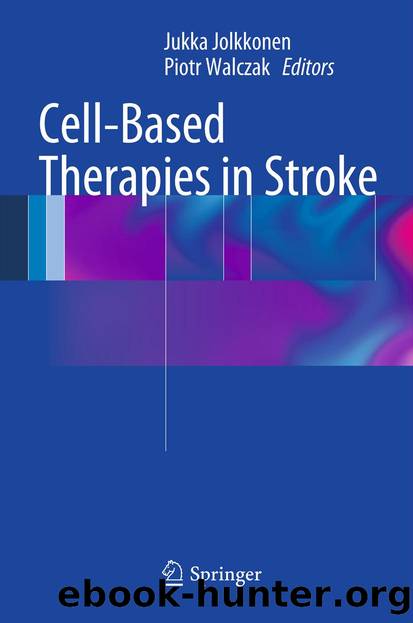Cell-Based Therapies in Stroke by Jukka Jolkkonen & Piotr Walczak

Author:Jukka Jolkkonen & Piotr Walczak
Language: eng
Format: epub
Publisher: Springer Vienna, Vienna
7.3 Noninvasive Monitoring of Tissue Regeneration
In situ tissue engineering is a further development of cell therapy (Yu and Morshead 2011). To generate new tissue, not only will implanted cells need to remain and survive within the lesion cavity, but there is also a requirement for a vascular network and site-appropriate differentiation as well as integration with the host brain tissue. Growth factors can be secreted from biomaterials to guide these processes (Lam et al. 2010). However, the number of processes that need to be controlled is staggering and is a dynamic process. Similar processes are well described in both mammalian development and invertebrate regeneration (Tanaka and Ferretti 2009). However, the unique situation of mammalian brain regeneration will require an equally unique set of processes to ensure that an appropriate tissue forms. Although some processes will be similar to those seen in development (Cramer and Chopp 2000), it is likely that they will be orchestrated in a different way, with sequence alteration and some entirely different processes. Moreover, by implanting cells and providing the structural substrate for these cells, these processes invoked might even be very different from those involved in true tissue regeneration as occurs in invertebrates.
To gain control over the processes and to ensure they synchronize to form a tissue, it will be important to have appropriate noninvasive-imaging techniques that can monitor these processes over time. Some biomaterials will have relaxivity properties and hence can easily be detected using MRI, but this inherent contrast will make it difficult to interrogate what changes occur within the lesion territory (Bible et al. 2009b). Therefore, a tunable or induced contrast in biomaterials might be desirable. Incorporating contrast agents into biomaterials, such as hydrogel, can make these visible on MRI without interfering with structural T2-weighted images (Karfeld-Sulzer et al. 2011; Kim et al. 2012). The release of contrast agents from biomaterials in conjunction with the release of growth factors also potentially provides a means to monitor their distribution and release kinetics in vivo (Onuki et al. 2010). This of course will be essential to also understand how factors released from biomaterials interact with the host brain. Multifunctional and multimodal materials (Yim et al. 2011) might therefore be needed to allow the simultaneous monitoring of various processes.
Detection of biomaterials used to engineer tissue, however, should not interfere with the visualization of tissue formation (Fig. 7.2). Only T2-weighted MR images will be insufficient to demonstrate tissue formation (Bible et al. 2012). Conventional MR contrast agents affect 1H and therefore are likely to affect T2-weighted images, whereas novel classes of contrast agents, such as 19F or chemical exchange saturation transfer (CEST), are likely to be better candidates to report on the presence of biomaterials. However, for regenerative imaging, it is even more important to be able to visualize biological processes rather than the biomaterials. One of the most basic elements of this is to monitor the presence of transplanted cells in vivo. Various strategies and imaging paradigms have been described for this cellular imaging (Modo et al.
Download
This site does not store any files on its server. We only index and link to content provided by other sites. Please contact the content providers to delete copyright contents if any and email us, we'll remove relevant links or contents immediately.
| Automotive | Engineering |
| Transportation |
Whiskies Galore by Ian Buxton(41879)
Introduction to Aircraft Design (Cambridge Aerospace Series) by John P. Fielding(33064)
Small Unmanned Fixed-wing Aircraft Design by Andrew J. Keane Andras Sobester James P. Scanlan & András Sóbester & James P. Scanlan(32743)
Craft Beer for the Homebrewer by Michael Agnew(18140)
Turbulence by E. J. Noyes(7936)
The Complete Stick Figure Physics Tutorials by Allen Sarah(7307)
Kaplan MCAT General Chemistry Review by Kaplan(6867)
The Thirst by Nesbo Jo(6828)
Bad Blood by John Carreyrou(6552)
Modelling of Convective Heat and Mass Transfer in Rotating Flows by Igor V. Shevchuk(6391)
Learning SQL by Alan Beaulieu(6211)
Weapons of Math Destruction by Cathy O'Neil(6146)
Man-made Catastrophes and Risk Information Concealment by Dmitry Chernov & Didier Sornette(5921)
Digital Minimalism by Cal Newport;(5664)
Life 3.0: Being Human in the Age of Artificial Intelligence by Tegmark Max(5474)
iGen by Jean M. Twenge(5366)
Secrets of Antigravity Propulsion: Tesla, UFOs, and Classified Aerospace Technology by Ph.D. Paul A. Laviolette(5309)
Design of Trajectory Optimization Approach for Space Maneuver Vehicle Skip Entry Problems by Runqi Chai & Al Savvaris & Antonios Tsourdos & Senchun Chai(5011)
Pale Blue Dot by Carl Sagan(4912)
